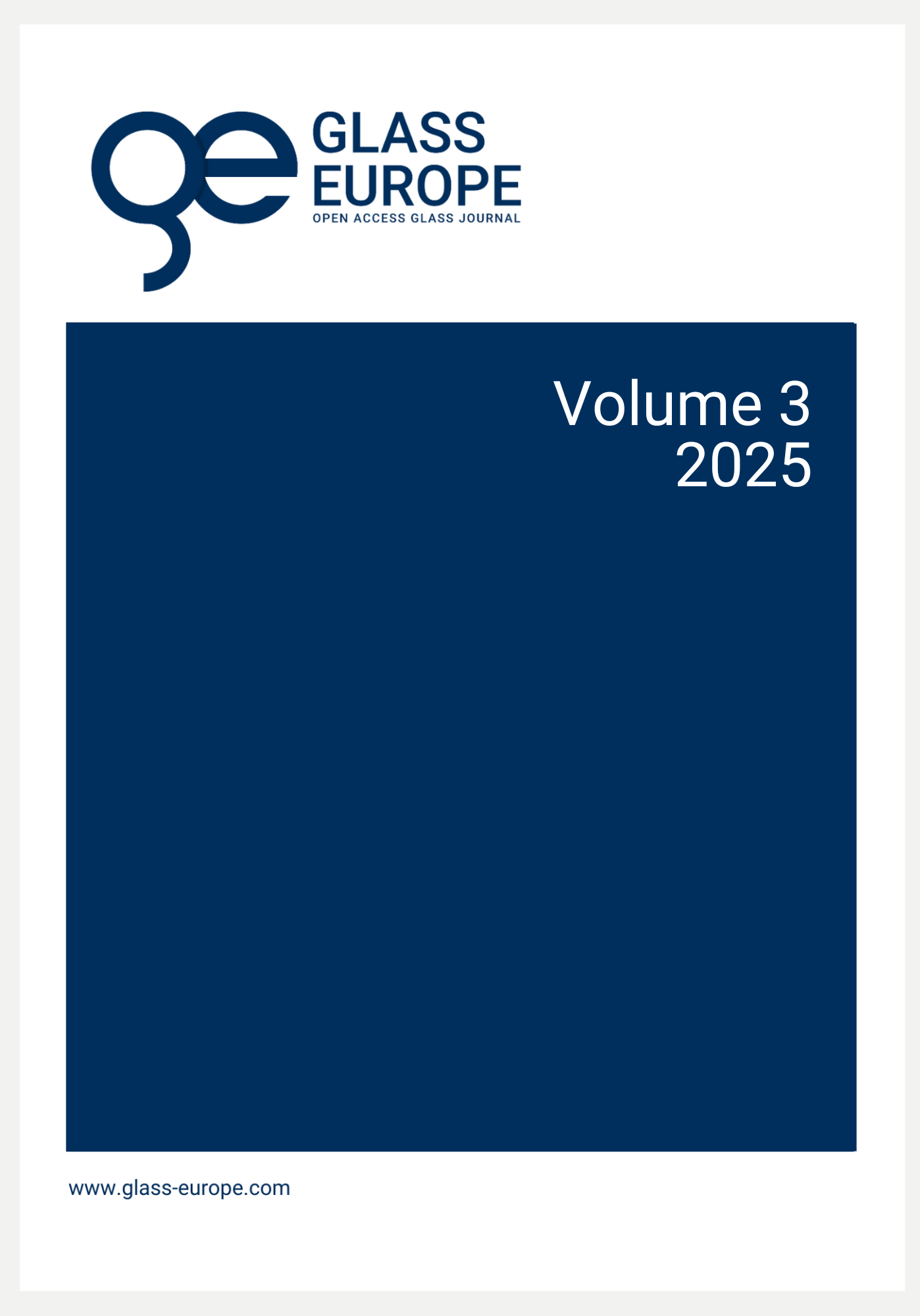Thermo-Optical Set-Up to Investigate Non-Isothermal Glass-Metal Contact
DOI:
https://doi.org/10.52825/glass-europe.v3i.2866Keywords:
Glass-Metal Contact, Glass-Oxide Contact, Wetting, StickingAbstract
The development of innovative mold materials and coatings for glass forming, relies on a profound understanding of the interaction between glass melt and the respective metallic or oxidic surface. In order to revise the existing theories on sticking temperatures and viscosities, a new thermo-optical setup was constructed that enables the investigation of the non-isothermal bonding behavior of glass melts on different substrates. A glass gob is generated in an upper furnace at temperatures of up to 1200 °C and is then poured onto an individually heated substrate (the respective contact material) at temperatures similar to container glass forming. The resulting movement of the gob at pouring and on the substrate is observed with a high-speed camera. The set-up was tested with a soda lime silicate glass melt in contact with various metallic, carbon-based and ceramic materials. Sticking temperatures for the different materials were determined and compared to the results found in literature. Contact temperatures at which sticking occurs varied significantly with the investigated material. A critical interface temperature (respectively viscosity of 108.8 Pas) as obtained by previous researchers could not be found, instead the temperature range for sticking was almost 200 K. Some materials resisted sticking even at temperatures up to 600 °C with the interface viscosity being below 108.8 Pas. Interestingly, those substrates also showed non-wetting behavior in previous heating micros-copy trials, suggesting that wettability plays a more important role for sticking than assumed so far.
Downloads
References
W. Giegerich and W. Trier, “Grundlagen der Formgebung,” in Glasmaschinen, H. Alb-recht, K. Becker et al., Eds. Berlin, Heidelberg: Springer Berlin Heidelberg, 1964, pp. 1–36, doi: 10.1007/978-3-662-25709-8_1 DOI: https://doi.org/10.1007/978-3-662-25709-8_1
R. Laniel, M. Hubert, M. Miroir, and A. Brient, “Glass shaping,” in Springer Handbook of Glass, J. D. Musgraves, J. Hu, and L. Calvez, Eds. Cham: Springer International Pub-lishing, 2019, pp. 1259–1292, doi: 10.1007/978-3-319-93728-1_36 DOI: https://doi.org/10.1007/978-3-319-93728-1_36
C. Roos, “Fabrication of Glass Containers,” in Encyclopedia of Glass Science, Tech-nology, History, and Culture, P. Richet, R. Conradt, A. Takada and J. Dyon, Eds., Wiley, 2021, pp.81-93, doi: 10.1002/9781118801017.ch1.5 DOI: https://doi.org/10.1002/9781118801017.ch1.5
P. Moreau, D. Lochegnies, S. Grégoire, and J. C. Sá, “Analysis of lubrication in glass blowing: heat transfer measurements and impact on forming,” Glass Technol.: Eur. J. Glass Sci. Technol. A, vol. 49, no. 1, pp. 8–16, 2008
H. Von Krüger and E. Wunderlich, “Form- und Oberflächenfehler an Hohl- und Preß-glas,” in Glastechnische Fabrikationsfehler, H. Jebsen-Marwedel and R. Brückner, Eds. Berlin, Heidelberg: Springer Berlin Heidelberg, 2011, pp. 403–446, doi: 10.1007/978-3-642-16433-0_9 DOI: https://doi.org/10.1007/978-3-642-16433-0_9
P. Manns, W. Döll, and G. Kleer, “Glass in contact with mould materials for container production,” Glass Science and Technology, vol. 68, no.12, pp.389-399,1995
D. Rieser, P. Manns, G. Spieß, and G. Kleer, “Investigations on sticking temperature and wear of mold materials and coatings,” in Advances in Fusion and Processing of Glass III, Hoboken, NJ, USA: John Wiley & Sons, Inc., 2006, pp. 281–289, doi: 10.1002/9781118405949.ch27 DOI: https://doi.org/10.1002/9781118405949.ch27
D. Rieser, G. Spieß, and P. Manns, “Investigations on glass-to-mold sticking in the hot forming process,” J. Non Cryst. Solids, vol. 354, no. 12–13, pp. 1393–1397, 2008, doi: 10.1016/j.jnoncrysol.2007.02.095 DOI: https://doi.org/10.1016/j.jnoncrysol.2007.02.095
D. Rieser “Untersuchungen zum Klebe- und Abriebverhalten von Formenwerkstoffen für die Heißformgebung von anorganischem Glas,” Pd.D. dissertation, Universität Karls-ruhe, Karlsruhe, Karlsruhe, Germany 2004
C. Roos, J.-H. Veltmaat, and P. Jacobs, “A new model for describing the glass to metal interaction in forming,” Glass Eur, vol. 2, pp. 137–149, 2024, doi: 10.52825/glass-europe.v2i.976 DOI: https://doi.org/10.52825/glass-europe.v2i.976
A. Fluegel “Glass viscosity calculation based on a global statistical modelling approach,” Glass Technol.: Eur. J. Glass Sci. Technol. A, vol.48, no.1, pp.13–30, 2007
A. Fluegel, D. A. Earl, A. K. Varshneya, and T. P. Seward III, “Density and thermal ex-pansion calculation of silicate glass melts from 1000 °C to 1400 °C”, Phys. Chem. Glasses: Eur. J. Glass Sci. Technol. B, vol. 49, no. 5, pp. 245–257, 2008
D. R. Cassar „GlassNet: A multitask deep neural network for predicting many glass properties“, Ceram. Int., vol. 49, no. 22, pp.36013-36024, 2023, doi: 10.1016/j.ceramint.2023.08.281 DOI: https://doi.org/10.1016/j.ceramint.2023.08.281
D. Pye, I. Joseph, and A. Montenero, Properties of glass-forming melts. Boca Raton, FL: CRC Press, 2005, doi: 10.1201/9781420027310 DOI: https://doi.org/10.1201/9781420027310
L. van der Tempel “Thermal Conductivity of a Glass: II. The Empirical Model”, Glas. Phys. Chem., vol. 28, no. 3, pp. 147–152, 2002, doi: 10.1023/A:1016095101094 DOI: https://doi.org/10.1023/A:1016095101094
W. M. Haynes, Ed., CRC Handbook of Chemistry and Physics, 97th ed., Boca Raton, FL: CRC Press, 2016, doi: 10.1201/9781315380476 DOI: https://doi.org/10.1201/9781315380476
P.J. Linstrom and W.G. Mallard, Eds., NIST Chemistry WebBook, NIST Standard Ref-erence Database Number 69, National Institute of Standards and Technology, Gaithersburg MD, 20899, doi: 10.18434/T4D303
H. D. Baehr and K. Stephen, Heat and mass-transfer, 2nd ed. Berlin, Germany: Sprin-ger, 2006 DOI: https://doi.org/10.1007/3-540-29527-5
G. L. Selman, M. R. Spender and A. S. Darling, “The Wetting of Platinum and Its Alloys by Glass”, Platin. Met. Rev., vol. 9, no. 3, pp. 92-99, 1965, doi: 10.1595/003214065X939299 DOI: https://doi.org/10.1595/003214065X939299
Downloads
Published
How to Cite
Issue
Section
License
Copyright (c) 2025 Pawel Engelmann; Christian Roos

This work is licensed under a Creative Commons Attribution 4.0 International License.
Accepted 2025-09-22
Published 2025-10-10
Funding data
-
Deutsche Forschungsgemeinschaft
Grant numbers RO 5831/8-1

